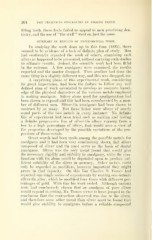Page 626 - My FlipBook
P. 626
304 THE TECHNICAL PBOCEDURES IN FILLING TEETH.
filling teeth, these facts failed to appeal to men practicing den-
tistry, and the use of "the stuff" went on just the same.
SUMMARY OF RESULTS OF EXPERIMENTAL WORK.
In studying the work done up to this time (1895), there
seemed to be evidence of a lack of definite plan of study. Men
had continually repeated the work of others, examining such
alloys as happened to be presented, without carrying such studies
to ultimate results. Indeed, the scientific work had been fitful
in the extreme. A few amalgams were examined, the results
reported and the matter dropped. Then another had done the
same thing in a slightly different way, and this was dropped, etc.
A surprising phase of this experimental work, considering
its great importance, had been the failure to follow any well
defined plan of work calculated to develop an accurate knowl-
edge of the physical characters of the various metals employed
in making amalgam. Silver alone used for amalgamation had
been shown to expand and this had been corroborated by a num-
ber of different men. Silver-tin amalgams had been shown to
contract by as many. But these latter were alloys of nearly
equal parts of the two metals in every instance. No definite
line of experiment had been tried such as making and testing
a definite progressive line of silver-tin alloj^s running from a
low to a high percentage of silver, that would give a view of
the properties developed by the possible variations of the pro-
portions of these metals.
Great search had been made among the possible metals for
amalgams and it had been very conclusively shown that alloys
composed of silver and tin must serve as the basis of dental
amalgams. Silver was the only metal found that would give
the necessary rigidity and stability to amalgams, while the com-
bination with tin alone could be depended upon to produce suf-
ficient soluliility of the silver in mercury. Other raotals could
only be regarded as modifiers, however important they might
prove in that capacity. On this line Charles S. Tomes had
reported one single series of experiments by making one definite
silver-tin alloy, which lie modified four times with different per-
centages of gold. With this his work ended. Although various
tests had conclusively shown that an amalgam of pure silver
would exjiand in setting, Mr. Tomes seems to have jumped to the
conclusion that the contraction observed was due to the silver,
and therefore some other metal than silver must be found that
would give stability to amalgams before a reliable compound


